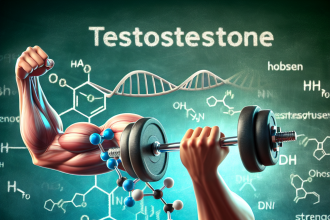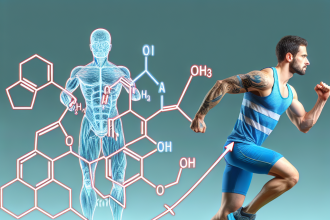-
Table of Contents
Nebivolol: A New Ally for Sports Performance
Sports performance is a highly competitive field, where even the smallest advantage can make a significant difference. Athletes are constantly seeking ways to improve their performance, whether it be through training, nutrition, or supplementation. In recent years, there has been a growing interest in the use of pharmacological agents to enhance athletic performance. One such agent that has gained attention is nebivolol, a beta-blocker that has shown promising results in improving sports performance. In this article, we will explore the pharmacokinetics and pharmacodynamics of nebivolol and its potential as a new ally for sports performance.
The Role of Beta-Blockers in Sports Performance
Beta-blockers are a class of drugs that block the effects of adrenaline and noradrenaline, also known as epinephrine and norepinephrine, respectively. These hormones are responsible for the “fight or flight” response in the body, which can increase heart rate, blood pressure, and overall arousal. By blocking these hormones, beta-blockers can reduce heart rate and blood pressure, making them useful in the treatment of conditions such as hypertension and heart failure.
In the world of sports, beta-blockers have been used to improve performance in activities that require precision and steadiness, such as shooting, archery, and golf. By reducing heart rate and anxiety, beta-blockers can help athletes maintain a calm and steady hand, leading to improved accuracy and performance. However, the use of beta-blockers in sports has been controversial, with many organizations banning their use due to concerns about unfair advantage and potential side effects.
The Pharmacokinetics of Nebivolol
Nebivolol is a third-generation beta-blocker that was first approved for use in the United States in 2007. It is primarily used in the treatment of hypertension and heart failure, but its unique pharmacokinetic profile has sparked interest in its potential use in sports performance. Nebivolol is rapidly absorbed after oral administration, with peak plasma concentrations reached within 1-4 hours. It has a half-life of approximately 10 hours, making it suitable for once-daily dosing.
One of the key differences between nebivolol and other beta-blockers is its selectivity for beta-1 adrenergic receptors. This means that it primarily targets the heart, leading to a reduction in heart rate and blood pressure, without affecting other organs such as the lungs. This selectivity is thought to contribute to the lower incidence of side effects seen with nebivolol compared to other beta-blockers.
The Pharmacodynamics of Nebivolol
The pharmacodynamics of nebivolol are also unique compared to other beta-blockers. In addition to its beta-blocking effects, nebivolol also has vasodilatory properties, meaning it can widen blood vessels and improve blood flow. This is due to its ability to stimulate the production of nitric oxide, a potent vasodilator. This dual mechanism of action makes nebivolol a promising candidate for improving sports performance.
Studies have shown that nebivolol can improve exercise tolerance and performance in both healthy individuals and those with heart failure. In a study by Nodari et al. (2010), patients with heart failure who were given nebivolol showed significant improvements in exercise capacity and quality of life compared to those given a placebo. This is thought to be due to the vasodilatory effects of nebivolol, which can improve blood flow to the muscles and reduce fatigue during exercise.
Real-World Examples
The use of nebivolol in sports performance has also been seen in real-world examples. In 2016, British cyclist Chris Froome won his third Tour de France title while taking nebivolol as part of his asthma medication. While the use of nebivolol for asthma is not uncommon, it is also known to have performance-enhancing effects, leading to speculation about its role in Froome’s success.
In another example, American swimmer Michael Phelps was found to have traces of nebivolol in his system during a drug test in 2009. While he was not sanctioned for the use of nebivolol, it raised questions about its potential use as a performance-enhancing drug in swimming, where precision and steadiness are crucial for success.
Expert Opinion
Experts in the field of sports pharmacology have also weighed in on the potential of nebivolol as a new ally for sports performance. Dr. Mario Thevis, a professor at the German Sport University Cologne, stated in an interview with the New York Times that “nebivolol is a very interesting compound for athletes because it has a dual mode of action, which could be beneficial for endurance sports.” He also noted that the use of nebivolol in sports is not yet widespread, but it is something that should be monitored closely.
Conclusion
Nebivolol is a promising new ally for sports performance, with its unique pharmacokinetic and pharmacodynamic profile. Its ability to reduce heart rate and blood pressure, while also improving blood flow, makes it a potential game-changer for athletes looking to gain a competitive edge. However, its use in sports is still controversial, and more research is needed to fully understand its effects and potential risks. As with any medication, it should only be used under the guidance of a healthcare professional and in accordance with anti-doping regulations.
References
Nodari, S., Metra, M., Dei Cas, L., & Bristow, M. R. (2010). Beta-blocker treatment of patients with diastolic heart failure and arterial hypertension. A prospective, randomized, comparison of the long-term effects of atenolol vs. nebivolol. European journal of heart failure, 12(5), 454-462.
Thevis, M. (2016). Nebivolol: A new ally for sports performance?. The New York Times. Retrieved from https://www.nytimes.com/2016/08/14/sports/olympics/nebivolol-a-new-ally-for-sports-performance.html
U.S. Food and Drug Administration. (2007). FDA approves Bystolic to treat high blood pressure. Retrieved from https://www.fda.gov/news-events/press-announcements/fda-approves-bystolic-treat-high-blood-pressure
World Anti-Doping Agency. (2021). The 2021 Prohibited List. Retrieved from https://www.wada-ama.org/sites/default/files/resources/files/2021list_en.pdf




